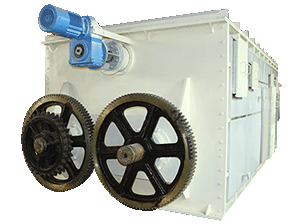Conductive drying, also known as contact drying, is very suitable for wet particles, while conductive dryers are more thermally efficient. Evaporated water vapor or organic solvent is withdrawn by vacuum or with a small amount of gas stream, which is the main carrier of moisture, and vacuum operation is recommended for heat sensitive granular materials. In a conduction dryer, a paddle dryer is used to dry the paste material. Rotary dryers with internal flow tubes have been designed and put into use. Vacuum drying is expensive, except that the material must be dried under low temperature or anoxic conditions, or when the material is dried under heating medium and high temperature, vacuum drying is recommended.
For a certain evaporation efficiency, it is more effective to use high temperature operation, which can reduce the gas flow rate and reduce the volume of the equipment. For low temperature drying operations, a suitable low temperature waste heat or solar collector can be selected as the heat source, but the dryer is relatively bulky. Freeze drying is a special case of drying under vacuum conditions.
Here, the temperature is below the three-state point of water, and water (or ice) is directly sublimated into water vapor. Although sublimation requires several times less heat than evaporation, other aspects of power consumption are greater, so vacuum drying costs are expensive. In the conduction heat transfer, heat is supplied to the dry material by a jacket, a stirring, a heat transfer tube, etc., and the heat medium is used instead of the hot air. A representative device is a slotted cylinder dryer. Conical stirring dryer, jacket and built-in heating tube rotary dryer, drum dryer, rake dryer, vacuum belt dryer, vacuum freeze dryer, etc. In hot air drying, the temperature during the constant-speed drying period corresponds to the wet bulb temperature.
In conduction heat transfer drying, it is necessary to artificially create a heating surface, so that the heat transfer area is small and the heat transfer coefficient is increased. In this way, the structure is more complicated and the equipment investment is larger than that of the hot air dryer. The conduction drying method indirectly transfers the heat required for drying through a surface such as a metal. The drying rate is lower than the direct drying method. The product temperature during constant-speed drying has no relationship with the temperature of the heating source, and is substantially the same as the saturation temperature of the gas pressure in the apparatus. In order to increase the drying rate and prevent uneven drying, mechanical agitation or the rotation of the container itself is usually used to increase or continuously update the heat transfer surface of the material, so it is necessary to further study the adhesion problem of the heat transfer mechanism.
The drying unit itself is expensive, but it is characterized by a small load on the dust collecting system, high thermal efficiency, easy recovery of the solvent, and the total cost is much cheaper than the direct drying method.
(1) The hollow paddle dryer, also known as the blade dryer, is mainly composed of a jacketed W-shaped casing and two hollow blade shafts and a transmission device. Hollow blades are arranged on the shaft, and the rotary end of the heat medium is introduced at the shaft end. The heat required to dry the moisture is conducted to the material by the inner wall of the jacketed W-shaped groove and the hollow blade wall. During the drying process, the hollow shaft with hollow blades agitates the material while heating the material, thereby updating the heating surface. It is a continuous conduction heating dryer. The heating medium is steam, hot water or heat transfer oil.
The heating medium is introduced into the casing jacket and the two hollow blade shafts to heat and dry the materials in a conductive manner, and the hollow shaft structure of different materials is different. The machine is suitable for processing various materials with good thermal stability such as paste, granule and powder. Under special conditions, the heat sensitive material can be dried and the solvent can be recovered during the drying process. It is commonly used for drying or cooling materials such as carbon black, light calcium carbonate, titanium dioxide, barium carbonate, nitrile uric acid, gypsum, clay, manganese dioxide, nylon and polyester chips, polyethylene, polypropylene (recovery solvent).
(2) The vacuum drier dryer is added from the top of the casing of the vacuum kneading dryer. Under the stirring of the rotating caries, the surface is continuously updated when the material is in contact with the casing wall, and the dried material is subjected to steam ( Or hot water, heat transfer oil) indirect heating, but the material moisture vaporization, vaporized moisture is pumped away by the vacuum pump in time. The material to be dried is indirectly heated by the heat carrier to vaporize the water in the material, and the vaporized water is discharged by the vacuum pump in time.
Due to the high degree of operating vacuum, generally in the range of 400-700 mmHg, the water vapor pressure on the surface of the dried material is much larger than the water vapor pressure in the evaporation space in the dryer housing. Thereby, it is beneficial to discharge the internal moisture and surface moisture of the material to be dried, and is beneficial to the movement of water molecules of the dried material to achieve the purpose of drying. The vacuum kneading dryer is suitable for heat sensitive materials that are easily oxidized at high temperatures or materials that are easy to be kneaded during drying, and materials that must be recovered from steam discharged during drying. Typical dry materials are sodium propylene sulfonate, CMC, phthalocyanine blue, dye intermediates, carboxymethyl starch, maltodextrin, hydrazine sulfonic acid and the like.
(3) The belt dryer consists of several independent unit sections. Each unit section includes a circulating fan, a heating device, a separate or common fresh air intake system, and an exhaust gas exhaust system. The operating parameters of the amount of drying medium, temperature, humidity and exhaust gas circulation can be independently controlled to ensure the reliability of the operation of the dryer and the optimization of operating conditions. With dry machine operation, wet material feeding, drying process in a completely sealed box, labor conditions are better, to avoid the leakage of dust. It is used for the drying of flake, strip and granular materials with good gas permeability. It is especially suitable for materials such as dehydrated vegetables and traditional Chinese medicine decoction pieces with high water content and high material temperature.
(4) Roller Scraper Dryer The drum scraper dryer is a continuous operation device for drying a liquid material or a strip material attached to the outer wall of the cylinder by means of a rotating cylinder by heat conduction. The liquid to be dried is flowed from the high level tank into the receiving tank of the drum dryer. The drying drum is driven by the transmission and rotates at a specified speed. The material is formed by a film coating device to form a film on the wall surface of the drum. The heating medium is continuously introduced into the cylinder, and the cylinder body is heated, and the moisture of the film is vaporized by the heat transfer of the cylinder wall, and then the material that meets the drying requirement is scraped off by a scraper, and is spirally conveyed into the storage tank for packaging.
The moisture removed by evaporation, depending on its nature, can be introduced into the corresponding treatment device through a closed hood; typically water vapor, which can be directly placed into the atmosphere by an exhaust pipe at the top of the hood. The machine is mainly used for the treatment of liquid materials, which can be heated and dried by steam, hot water or hot oil, or cooled by cold water. According to different material properties and process requirements, immersion, spray, and milled auxiliary feeding methods can be adopted.
(5) Double-cone rotary vacuum dryer The double-cone rotary vacuum dryer has a slightly olive-like shape with a cover at both ends, and two shafts are arranged in the middle to support the body. The body has a jacket to heat, and the body can be rotated when dry, so that the material and the wall are frequently replaced, which overcomes the disadvantage that the material in the vacuum oven mainly passes through the heating cylinder and has low thermal efficiency.
Rotary vacuum dryers have been widely used in fine chemicals and medicines, and are not suitable for materials with high viscosity or strong adhesion during the turning process. The equipment is mainly used for concentrating, mixing, drying and low-temperature drying materials (such as biochemical products) of powder, granular and fibrous materials in the pharmaceutical, chemical and food industries, and is more suitable for oxidizing, volatile and heat sensitive. Strongly irritating, toxic materials and drying of materials that do not allow damage to the crystals.
(6) Vacuum oven After evaporation, the evaporation temperature of the volatiles contained in the material evaporation can be reduced, which is suitable for drying various heat sensitive and easy oxide materials. This device is often a cylinder or other vacuum-operated outer casing. It is heated by electric heating or hot water or heat-conducting oil through a heating plate or a heating pipe, and is suitable for batch production in small batches. The oven is a general-purpose drying equipment with a wide application surface. It is a tray-type intermittent drying equipment and is used in pharmaceutical, chemical and food. Heat curing, drying and dehydration of materials and products in light industry, heavy industry and other industries. Such as raw materials, raw drugs, Chinese herbal medicine pieces, extracts, powders, granules, granules, water pills, packaging bottles, pigment dyes, dehydrated vegetables, dried fruits, sausages, plastic resins, electrical components, baking varnish and so on.
(7) Freeze dryer The freeze dryer is to freeze and freeze the feed liquid, and then depressurize the ice to sublimate the ice to obtain a dry material. Since the whole process is carried out below freezing point, it is often used for drying of heat sensitive articles. It is difficult to heat the frozen material under vacuum, and the condensed sublimated water vapor under reduced pressure requires a large refrigeration system, so the drying cost is large. The moisture in the highly heat sensitive material is frozen and will be maintained at a temperature below freezing below under high vacuum. The water is sublimed to separate from the material. The loss of active ingredients in the material is small, but the drying rate is low.



